Legal Analysis of R v Robertson [2017] QCA 164 - Queensland Law
VerifiedAdded on 2020/02/24
|9
|2045
|136
Report
AI Summary
This report provides a detailed legal analysis of the case R v Robertson [2017] QCA 164, where the appellant, having pleaded guilty to attempted arson, appealed the district court's sentence. The analysis explores the appellant's grounds for appeal, including the mischaracterization of criminality, procedural fairness, the imposition of imprisonment as a last resort, and the manifest excess of the punishment. The report examines the judgments of Philippides JA, Atkinson J, and Morrison JA, highlighting their findings on the seriousness of the offense, the application of procedural fairness, and the appropriateness of the sentence. The analysis also delves into the relevant sections of the Criminal Code and the Punishment and Sentences Act 1992, particularly concerning attempted arson and the setting of parole release dates. The report concludes by discussing the impact of the court's decision on the appellant's prison time and considers a hypothetical scenario involving arson, contrasting it with attempted arson, and exploring the potential implications on sentencing.
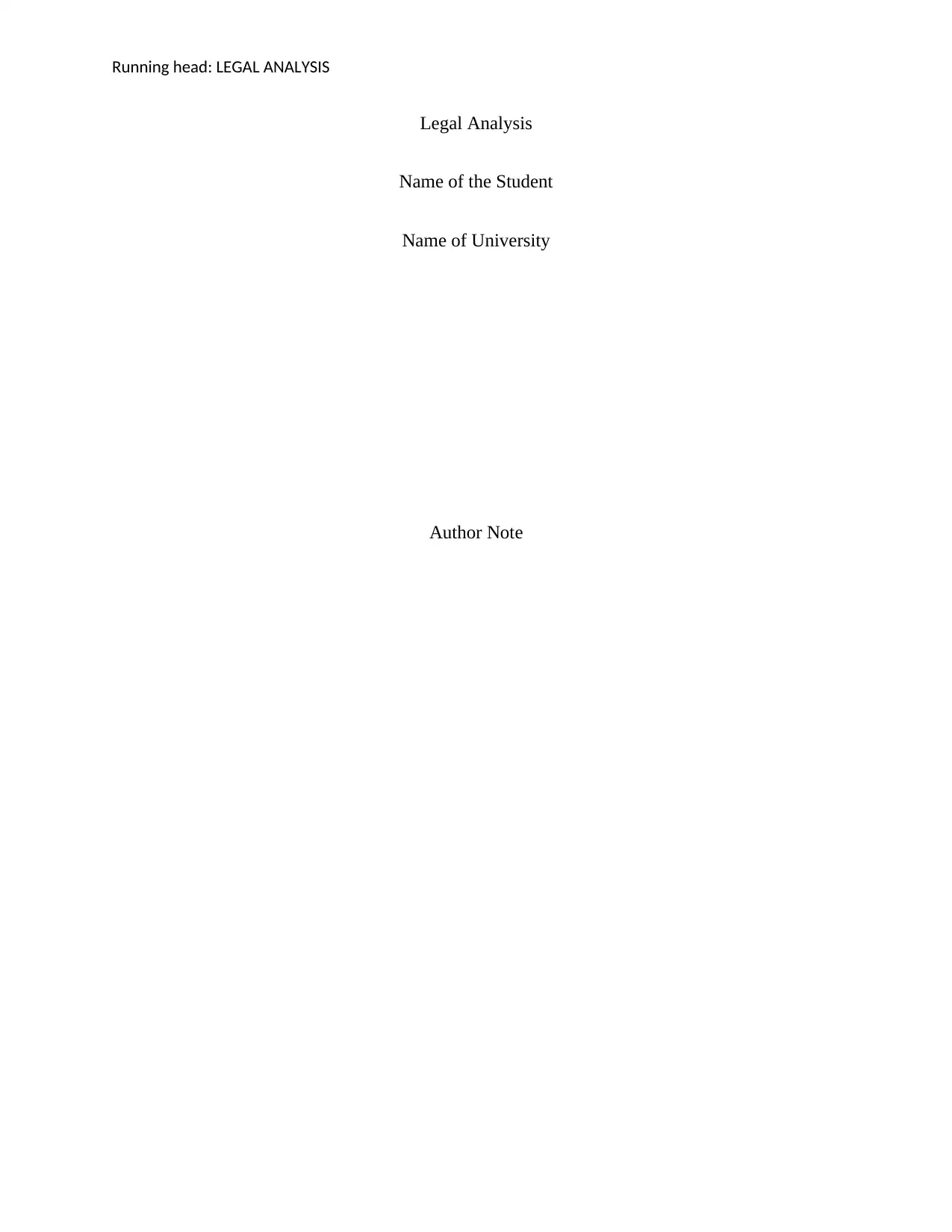
Running head: LEGAL ANALYSIS
Legal Analysis
Name of the Student
Name of University
Author Note
Legal Analysis
Name of the Student
Name of University
Author Note
Paraphrase This Document
Need a fresh take? Get an instant paraphrase of this document with our AI Paraphraser
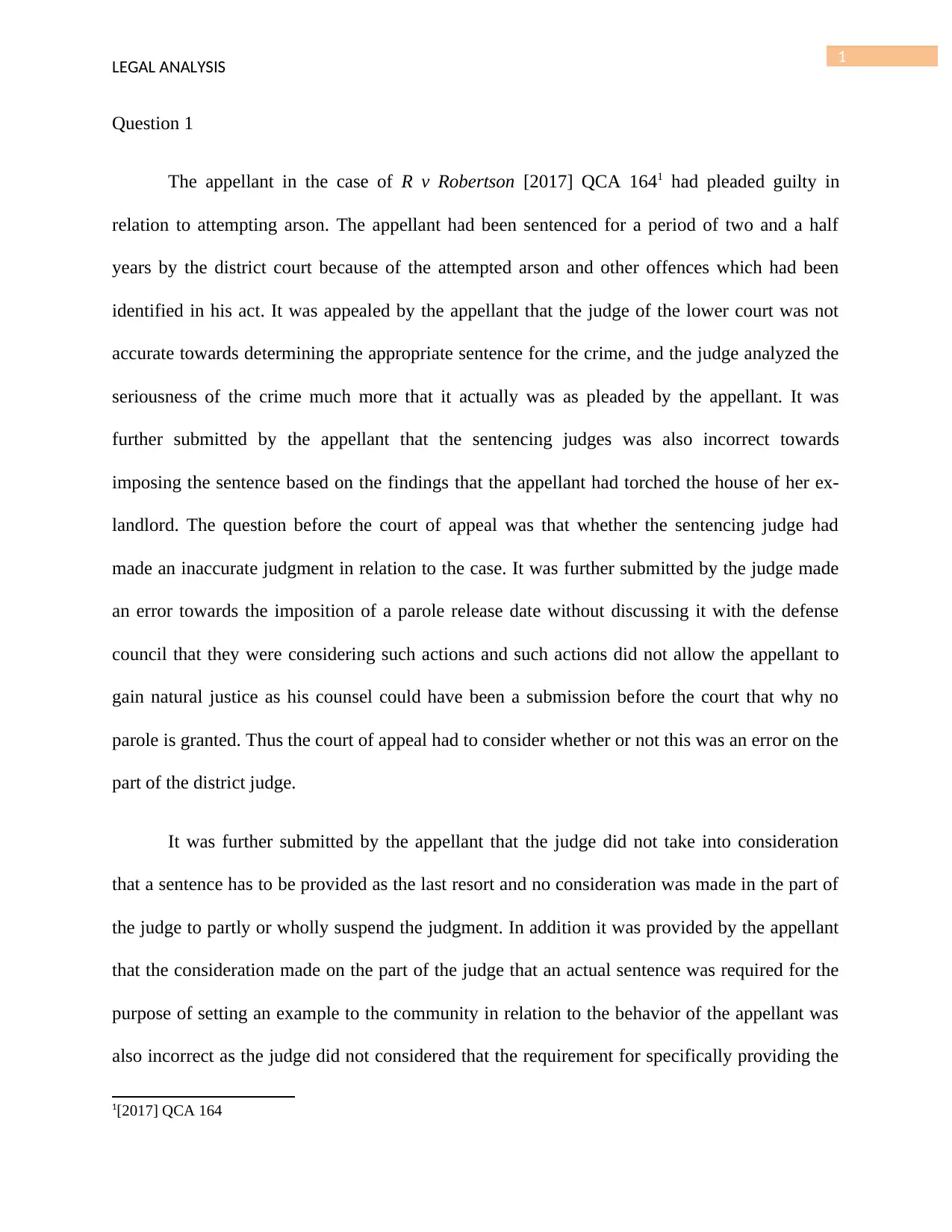
1
LEGAL ANALYSIS
Question 1
The appellant in the case of R v Robertson [2017] QCA 1641 had pleaded guilty in
relation to attempting arson. The appellant had been sentenced for a period of two and a half
years by the district court because of the attempted arson and other offences which had been
identified in his act. It was appealed by the appellant that the judge of the lower court was not
accurate towards determining the appropriate sentence for the crime, and the judge analyzed the
seriousness of the crime much more that it actually was as pleaded by the appellant. It was
further submitted by the appellant that the sentencing judges was also incorrect towards
imposing the sentence based on the findings that the appellant had torched the house of her ex-
landlord. The question before the court of appeal was that whether the sentencing judge had
made an inaccurate judgment in relation to the case. It was further submitted by the judge made
an error towards the imposition of a parole release date without discussing it with the defense
council that they were considering such actions and such actions did not allow the appellant to
gain natural justice as his counsel could have been a submission before the court that why no
parole is granted. Thus the court of appeal had to consider whether or not this was an error on the
part of the district judge.
It was further submitted by the appellant that the judge did not take into consideration
that a sentence has to be provided as the last resort and no consideration was made in the part of
the judge to partly or wholly suspend the judgment. In addition it was provided by the appellant
that the consideration made on the part of the judge that an actual sentence was required for the
purpose of setting an example to the community in relation to the behavior of the appellant was
also incorrect as the judge did not considered that the requirement for specifically providing the
1[2017] QCA 164
LEGAL ANALYSIS
Question 1
The appellant in the case of R v Robertson [2017] QCA 1641 had pleaded guilty in
relation to attempting arson. The appellant had been sentenced for a period of two and a half
years by the district court because of the attempted arson and other offences which had been
identified in his act. It was appealed by the appellant that the judge of the lower court was not
accurate towards determining the appropriate sentence for the crime, and the judge analyzed the
seriousness of the crime much more that it actually was as pleaded by the appellant. It was
further submitted by the appellant that the sentencing judges was also incorrect towards
imposing the sentence based on the findings that the appellant had torched the house of her ex-
landlord. The question before the court of appeal was that whether the sentencing judge had
made an inaccurate judgment in relation to the case. It was further submitted by the judge made
an error towards the imposition of a parole release date without discussing it with the defense
council that they were considering such actions and such actions did not allow the appellant to
gain natural justice as his counsel could have been a submission before the court that why no
parole is granted. Thus the court of appeal had to consider whether or not this was an error on the
part of the district judge.
It was further submitted by the appellant that the judge did not take into consideration
that a sentence has to be provided as the last resort and no consideration was made in the part of
the judge to partly or wholly suspend the judgment. In addition it was provided by the appellant
that the consideration made on the part of the judge that an actual sentence was required for the
purpose of setting an example to the community in relation to the behavior of the appellant was
also incorrect as the judge did not considered that the requirement for specifically providing the
1[2017] QCA 164
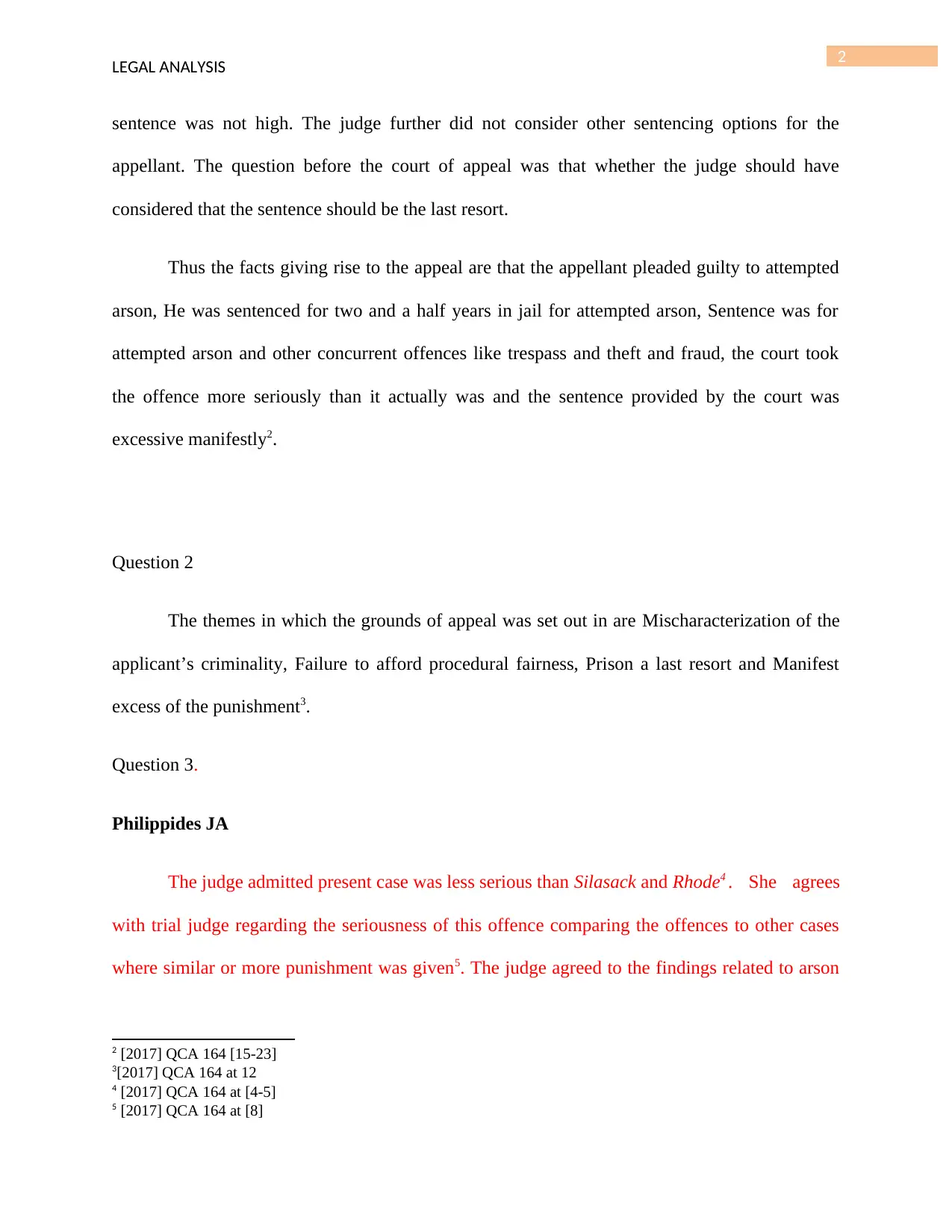
2
LEGAL ANALYSIS
sentence was not high. The judge further did not consider other sentencing options for the
appellant. The question before the court of appeal was that whether the judge should have
considered that the sentence should be the last resort.
Thus the facts giving rise to the appeal are that the appellant pleaded guilty to attempted
arson, He was sentenced for two and a half years in jail for attempted arson, Sentence was for
attempted arson and other concurrent offences like trespass and theft and fraud, the court took
the offence more seriously than it actually was and the sentence provided by the court was
excessive manifestly2.
Question 2
The themes in which the grounds of appeal was set out in are Mischaracterization of the
applicant’s criminality, Failure to afford procedural fairness, Prison a last resort and Manifest
excess of the punishment3.
Question 3.
Philippides JA
The judge admitted present case was less serious than Silasack and Rhode4 . She agrees
with trial judge regarding the seriousness of this offence comparing the offences to other cases
where similar or more punishment was given5. The judge agreed to the findings related to arson
2 [2017] QCA 164 [15-23]
3[2017] QCA 164 at 12
4 [2017] QCA 164 at [4-5]
5 [2017] QCA 164 at [8]
LEGAL ANALYSIS
sentence was not high. The judge further did not consider other sentencing options for the
appellant. The question before the court of appeal was that whether the judge should have
considered that the sentence should be the last resort.
Thus the facts giving rise to the appeal are that the appellant pleaded guilty to attempted
arson, He was sentenced for two and a half years in jail for attempted arson, Sentence was for
attempted arson and other concurrent offences like trespass and theft and fraud, the court took
the offence more seriously than it actually was and the sentence provided by the court was
excessive manifestly2.
Question 2
The themes in which the grounds of appeal was set out in are Mischaracterization of the
applicant’s criminality, Failure to afford procedural fairness, Prison a last resort and Manifest
excess of the punishment3.
Question 3.
Philippides JA
The judge admitted present case was less serious than Silasack and Rhode4 . She agrees
with trial judge regarding the seriousness of this offence comparing the offences to other cases
where similar or more punishment was given5. The judge agreed to the findings related to arson
2 [2017] QCA 164 [15-23]
3[2017] QCA 164 at 12
4 [2017] QCA 164 at [4-5]
5 [2017] QCA 164 at [8]
⊘ This is a preview!⊘
Do you want full access?
Subscribe today to unlock all pages.

Trusted by 1+ million students worldwide
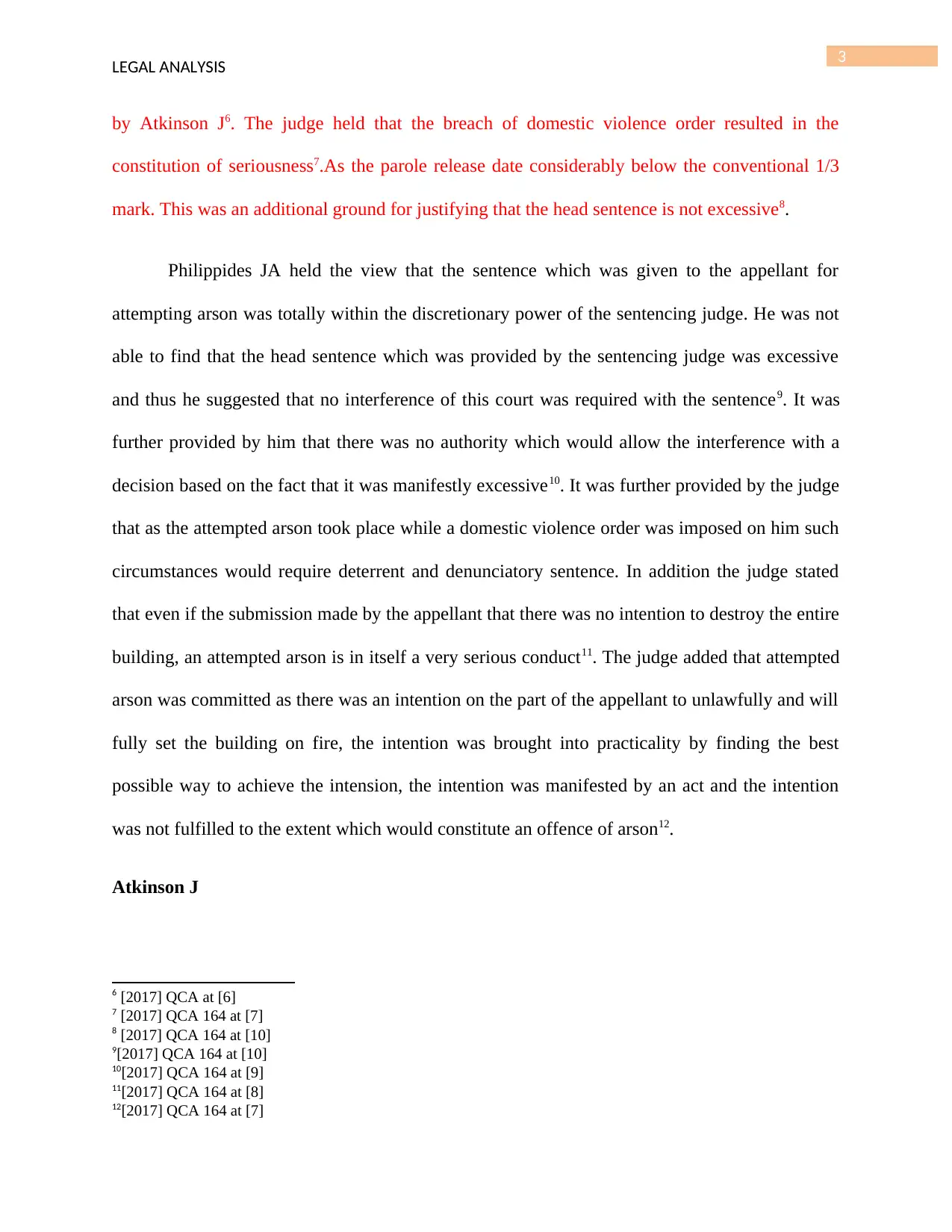
3
LEGAL ANALYSIS
by Atkinson J6. The judge held that the breach of domestic violence order resulted in the
constitution of seriousness7.As the parole release date considerably below the conventional 1/3
mark. This was an additional ground for justifying that the head sentence is not excessive8.
Philippides JA held the view that the sentence which was given to the appellant for
attempting arson was totally within the discretionary power of the sentencing judge. He was not
able to find that the head sentence which was provided by the sentencing judge was excessive
and thus he suggested that no interference of this court was required with the sentence9. It was
further provided by him that there was no authority which would allow the interference with a
decision based on the fact that it was manifestly excessive10. It was further provided by the judge
that as the attempted arson took place while a domestic violence order was imposed on him such
circumstances would require deterrent and denunciatory sentence. In addition the judge stated
that even if the submission made by the appellant that there was no intention to destroy the entire
building, an attempted arson is in itself a very serious conduct11. The judge added that attempted
arson was committed as there was an intention on the part of the appellant to unlawfully and will
fully set the building on fire, the intention was brought into practicality by finding the best
possible way to achieve the intension, the intention was manifested by an act and the intention
was not fulfilled to the extent which would constitute an offence of arson12.
Atkinson J
6 [2017] QCA at [6]
7 [2017] QCA 164 at [7]
8 [2017] QCA 164 at [10]
9[2017] QCA 164 at [10]
10[2017] QCA 164 at [9]
11[2017] QCA 164 at [8]
12[2017] QCA 164 at [7]
LEGAL ANALYSIS
by Atkinson J6. The judge held that the breach of domestic violence order resulted in the
constitution of seriousness7.As the parole release date considerably below the conventional 1/3
mark. This was an additional ground for justifying that the head sentence is not excessive8.
Philippides JA held the view that the sentence which was given to the appellant for
attempting arson was totally within the discretionary power of the sentencing judge. He was not
able to find that the head sentence which was provided by the sentencing judge was excessive
and thus he suggested that no interference of this court was required with the sentence9. It was
further provided by him that there was no authority which would allow the interference with a
decision based on the fact that it was manifestly excessive10. It was further provided by the judge
that as the attempted arson took place while a domestic violence order was imposed on him such
circumstances would require deterrent and denunciatory sentence. In addition the judge stated
that even if the submission made by the appellant that there was no intention to destroy the entire
building, an attempted arson is in itself a very serious conduct11. The judge added that attempted
arson was committed as there was an intention on the part of the appellant to unlawfully and will
fully set the building on fire, the intention was brought into practicality by finding the best
possible way to achieve the intension, the intention was manifested by an act and the intention
was not fulfilled to the extent which would constitute an offence of arson12.
Atkinson J
6 [2017] QCA at [6]
7 [2017] QCA 164 at [7]
8 [2017] QCA 164 at [10]
9[2017] QCA 164 at [10]
10[2017] QCA 164 at [9]
11[2017] QCA 164 at [8]
12[2017] QCA 164 at [7]
Paraphrase This Document
Need a fresh take? Get an instant paraphrase of this document with our AI Paraphraser
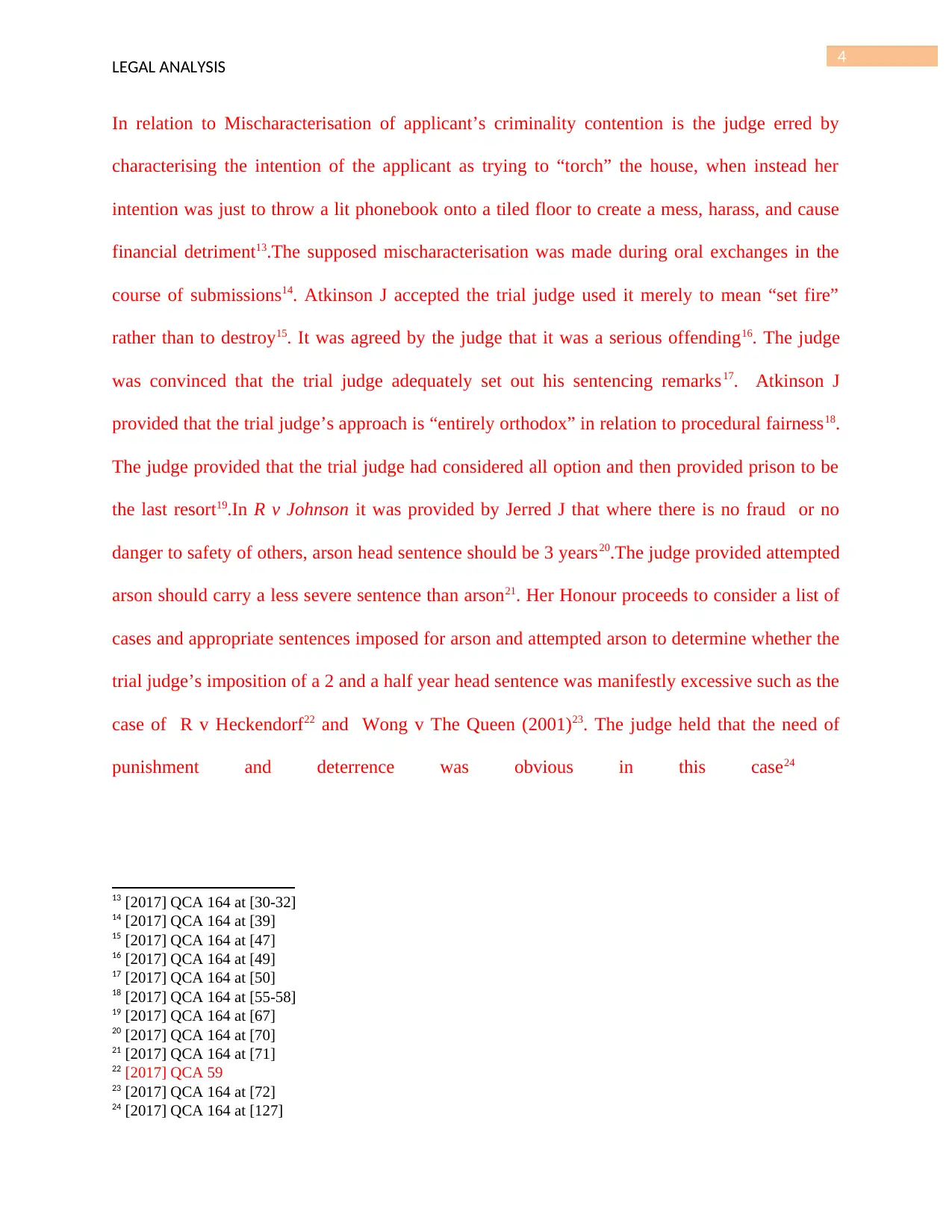
4
LEGAL ANALYSIS
In relation to Mischaracterisation of applicant’s criminality contention is the judge erred by
characterising the intention of the applicant as trying to “torch” the house, when instead her
intention was just to throw a lit phonebook onto a tiled floor to create a mess, harass, and cause
financial detriment13.The supposed mischaracterisation was made during oral exchanges in the
course of submissions14. Atkinson J accepted the trial judge used it merely to mean “set fire”
rather than to destroy15. It was agreed by the judge that it was a serious offending16. The judge
was convinced that the trial judge adequately set out his sentencing remarks17. Atkinson J
provided that the trial judge’s approach is “entirely orthodox” in relation to procedural fairness18.
The judge provided that the trial judge had considered all option and then provided prison to be
the last resort19.In R v Johnson it was provided by Jerred J that where there is no fraud or no
danger to safety of others, arson head sentence should be 3 years20.The judge provided attempted
arson should carry a less severe sentence than arson21. Her Honour proceeds to consider a list of
cases and appropriate sentences imposed for arson and attempted arson to determine whether the
trial judge’s imposition of a 2 and a half year head sentence was manifestly excessive such as the
case of R v Heckendorf22 and Wong v The Queen (2001)23. The judge held that the need of
punishment and deterrence was obvious in this case24
13 [2017] QCA 164 at [30-32]
14 [2017] QCA 164 at [39]
15 [2017] QCA 164 at [47]
16 [2017] QCA 164 at [49]
17 [2017] QCA 164 at [50]
18 [2017] QCA 164 at [55-58]
19 [2017] QCA 164 at [67]
20 [2017] QCA 164 at [70]
21 [2017] QCA 164 at [71]
22 [2017] QCA 59
23 [2017] QCA 164 at [72]
24 [2017] QCA 164 at [127]
LEGAL ANALYSIS
In relation to Mischaracterisation of applicant’s criminality contention is the judge erred by
characterising the intention of the applicant as trying to “torch” the house, when instead her
intention was just to throw a lit phonebook onto a tiled floor to create a mess, harass, and cause
financial detriment13.The supposed mischaracterisation was made during oral exchanges in the
course of submissions14. Atkinson J accepted the trial judge used it merely to mean “set fire”
rather than to destroy15. It was agreed by the judge that it was a serious offending16. The judge
was convinced that the trial judge adequately set out his sentencing remarks17. Atkinson J
provided that the trial judge’s approach is “entirely orthodox” in relation to procedural fairness18.
The judge provided that the trial judge had considered all option and then provided prison to be
the last resort19.In R v Johnson it was provided by Jerred J that where there is no fraud or no
danger to safety of others, arson head sentence should be 3 years20.The judge provided attempted
arson should carry a less severe sentence than arson21. Her Honour proceeds to consider a list of
cases and appropriate sentences imposed for arson and attempted arson to determine whether the
trial judge’s imposition of a 2 and a half year head sentence was manifestly excessive such as the
case of R v Heckendorf22 and Wong v The Queen (2001)23. The judge held that the need of
punishment and deterrence was obvious in this case24
13 [2017] QCA 164 at [30-32]
14 [2017] QCA 164 at [39]
15 [2017] QCA 164 at [47]
16 [2017] QCA 164 at [49]
17 [2017] QCA 164 at [50]
18 [2017] QCA 164 at [55-58]
19 [2017] QCA 164 at [67]
20 [2017] QCA 164 at [70]
21 [2017] QCA 164 at [71]
22 [2017] QCA 59
23 [2017] QCA 164 at [72]
24 [2017] QCA 164 at [127]
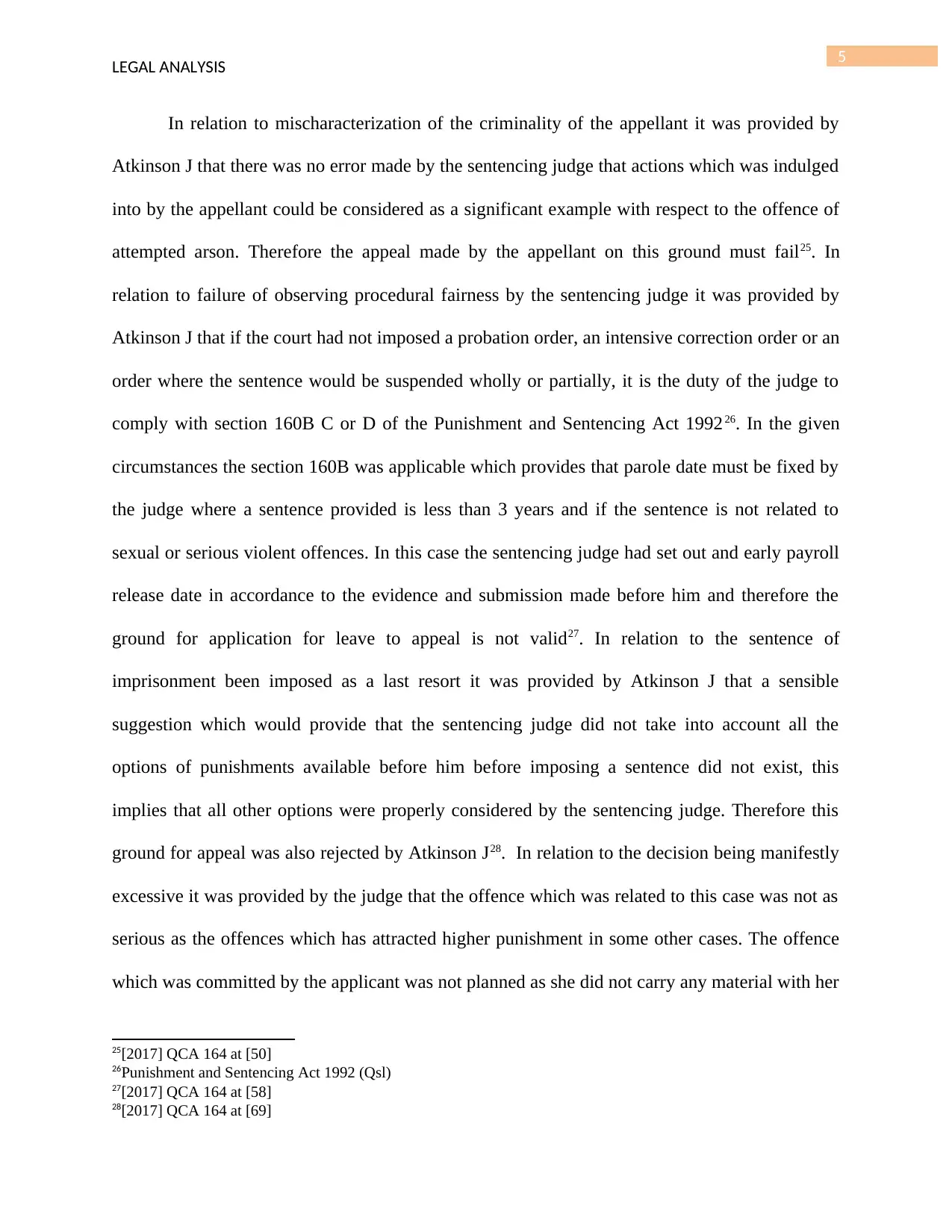
5
LEGAL ANALYSIS
In relation to mischaracterization of the criminality of the appellant it was provided by
Atkinson J that there was no error made by the sentencing judge that actions which was indulged
into by the appellant could be considered as a significant example with respect to the offence of
attempted arson. Therefore the appeal made by the appellant on this ground must fail25. In
relation to failure of observing procedural fairness by the sentencing judge it was provided by
Atkinson J that if the court had not imposed a probation order, an intensive correction order or an
order where the sentence would be suspended wholly or partially, it is the duty of the judge to
comply with section 160B C or D of the Punishment and Sentencing Act 199226. In the given
circumstances the section 160B was applicable which provides that parole date must be fixed by
the judge where a sentence provided is less than 3 years and if the sentence is not related to
sexual or serious violent offences. In this case the sentencing judge had set out and early payroll
release date in accordance to the evidence and submission made before him and therefore the
ground for application for leave to appeal is not valid27. In relation to the sentence of
imprisonment been imposed as a last resort it was provided by Atkinson J that a sensible
suggestion which would provide that the sentencing judge did not take into account all the
options of punishments available before him before imposing a sentence did not exist, this
implies that all other options were properly considered by the sentencing judge. Therefore this
ground for appeal was also rejected by Atkinson J28. In relation to the decision being manifestly
excessive it was provided by the judge that the offence which was related to this case was not as
serious as the offences which has attracted higher punishment in some other cases. The offence
which was committed by the applicant was not planned as she did not carry any material with her
25[2017] QCA 164 at [50]
26Punishment and Sentencing Act 1992 (Qsl)
27[2017] QCA 164 at [58]
28[2017] QCA 164 at [69]
LEGAL ANALYSIS
In relation to mischaracterization of the criminality of the appellant it was provided by
Atkinson J that there was no error made by the sentencing judge that actions which was indulged
into by the appellant could be considered as a significant example with respect to the offence of
attempted arson. Therefore the appeal made by the appellant on this ground must fail25. In
relation to failure of observing procedural fairness by the sentencing judge it was provided by
Atkinson J that if the court had not imposed a probation order, an intensive correction order or an
order where the sentence would be suspended wholly or partially, it is the duty of the judge to
comply with section 160B C or D of the Punishment and Sentencing Act 199226. In the given
circumstances the section 160B was applicable which provides that parole date must be fixed by
the judge where a sentence provided is less than 3 years and if the sentence is not related to
sexual or serious violent offences. In this case the sentencing judge had set out and early payroll
release date in accordance to the evidence and submission made before him and therefore the
ground for application for leave to appeal is not valid27. In relation to the sentence of
imprisonment been imposed as a last resort it was provided by Atkinson J that a sensible
suggestion which would provide that the sentencing judge did not take into account all the
options of punishments available before him before imposing a sentence did not exist, this
implies that all other options were properly considered by the sentencing judge. Therefore this
ground for appeal was also rejected by Atkinson J28. In relation to the decision being manifestly
excessive it was provided by the judge that the offence which was related to this case was not as
serious as the offences which has attracted higher punishment in some other cases. The offence
which was committed by the applicant was not planned as she did not carry any material with her
25[2017] QCA 164 at [50]
26Punishment and Sentencing Act 1992 (Qsl)
27[2017] QCA 164 at [58]
28[2017] QCA 164 at [69]
⊘ This is a preview!⊘
Do you want full access?
Subscribe today to unlock all pages.

Trusted by 1+ million students worldwide
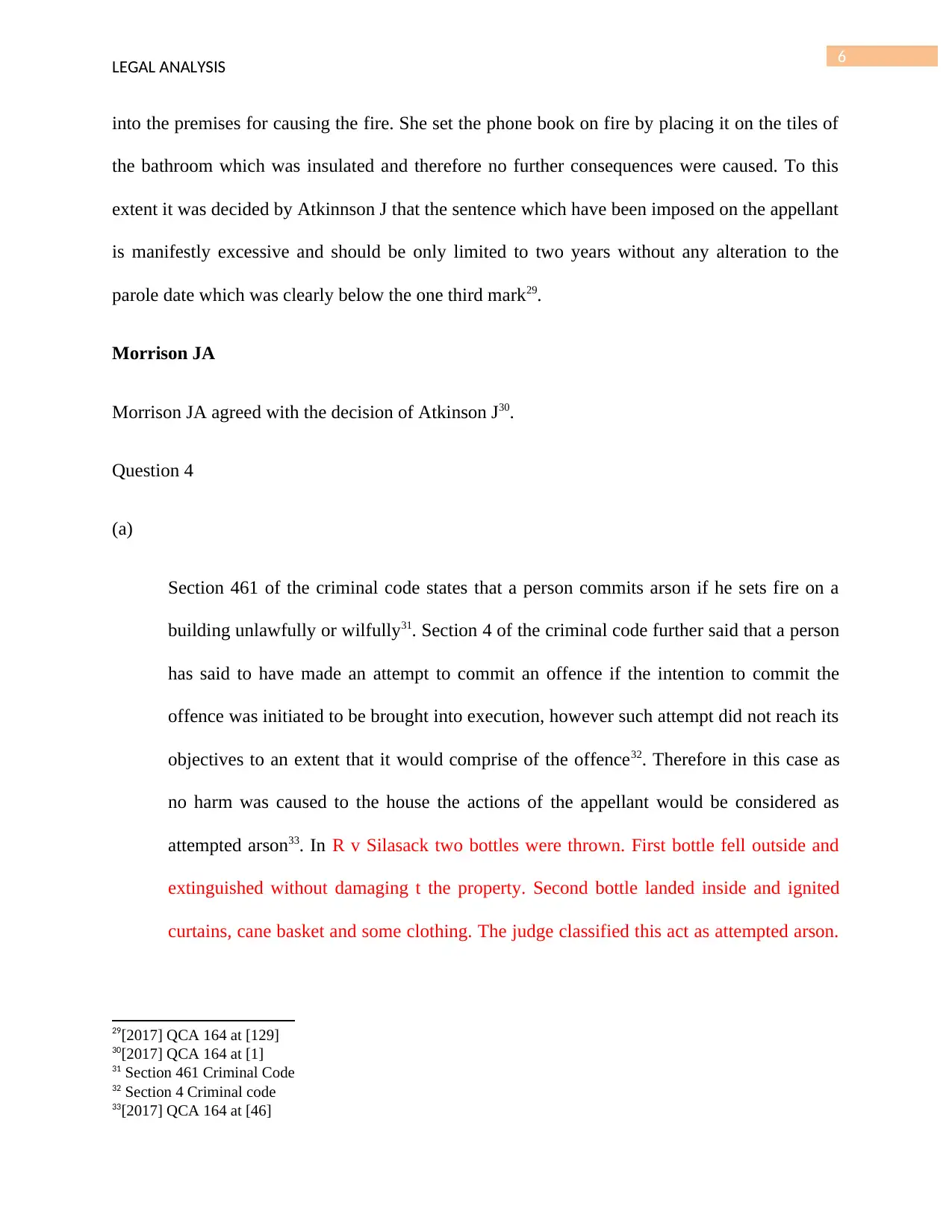
6
LEGAL ANALYSIS
into the premises for causing the fire. She set the phone book on fire by placing it on the tiles of
the bathroom which was insulated and therefore no further consequences were caused. To this
extent it was decided by Atkinnson J that the sentence which have been imposed on the appellant
is manifestly excessive and should be only limited to two years without any alteration to the
parole date which was clearly below the one third mark29.
Morrison JA
Morrison JA agreed with the decision of Atkinson J30.
Question 4
(a)
Section 461 of the criminal code states that a person commits arson if he sets fire on a
building unlawfully or wilfully31. Section 4 of the criminal code further said that a person
has said to have made an attempt to commit an offence if the intention to commit the
offence was initiated to be brought into execution, however such attempt did not reach its
objectives to an extent that it would comprise of the offence32. Therefore in this case as
no harm was caused to the house the actions of the appellant would be considered as
attempted arson33. In R v Silasack two bottles were thrown. First bottle fell outside and
extinguished without damaging t the property. Second bottle landed inside and ignited
curtains, cane basket and some clothing. The judge classified this act as attempted arson.
29[2017] QCA 164 at [129]
30[2017] QCA 164 at [1]
31 Section 461 Criminal Code
32 Section 4 Criminal code
33[2017] QCA 164 at [46]
LEGAL ANALYSIS
into the premises for causing the fire. She set the phone book on fire by placing it on the tiles of
the bathroom which was insulated and therefore no further consequences were caused. To this
extent it was decided by Atkinnson J that the sentence which have been imposed on the appellant
is manifestly excessive and should be only limited to two years without any alteration to the
parole date which was clearly below the one third mark29.
Morrison JA
Morrison JA agreed with the decision of Atkinson J30.
Question 4
(a)
Section 461 of the criminal code states that a person commits arson if he sets fire on a
building unlawfully or wilfully31. Section 4 of the criminal code further said that a person
has said to have made an attempt to commit an offence if the intention to commit the
offence was initiated to be brought into execution, however such attempt did not reach its
objectives to an extent that it would comprise of the offence32. Therefore in this case as
no harm was caused to the house the actions of the appellant would be considered as
attempted arson33. In R v Silasack two bottles were thrown. First bottle fell outside and
extinguished without damaging t the property. Second bottle landed inside and ignited
curtains, cane basket and some clothing. The judge classified this act as attempted arson.
29[2017] QCA 164 at [129]
30[2017] QCA 164 at [1]
31 Section 461 Criminal Code
32 Section 4 Criminal code
33[2017] QCA 164 at [46]
Paraphrase This Document
Need a fresh take? Get an instant paraphrase of this document with our AI Paraphraser
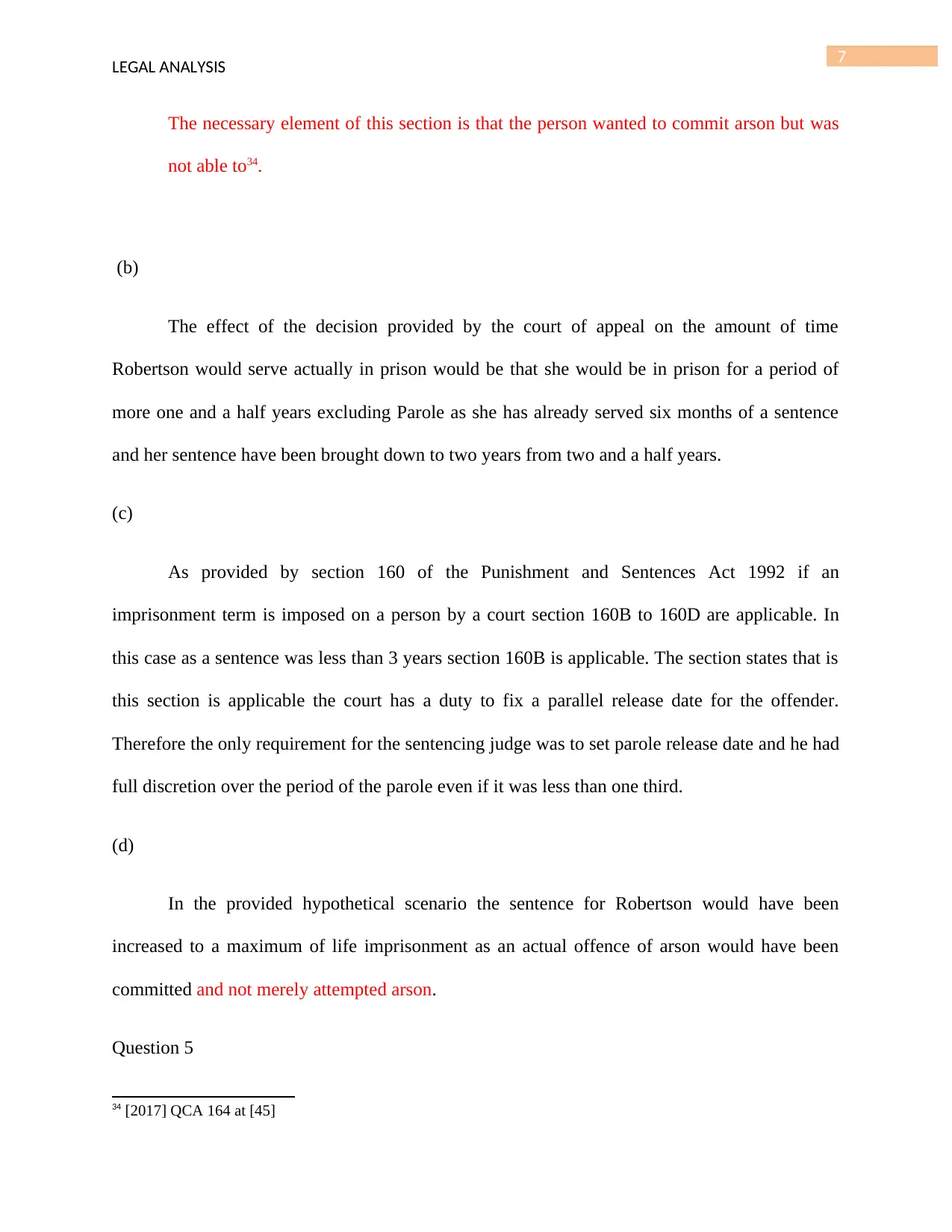
7
LEGAL ANALYSIS
The necessary element of this section is that the person wanted to commit arson but was
not able to34.
(b)
The effect of the decision provided by the court of appeal on the amount of time
Robertson would serve actually in prison would be that she would be in prison for a period of
more one and a half years excluding Parole as she has already served six months of a sentence
and her sentence have been brought down to two years from two and a half years.
(c)
As provided by section 160 of the Punishment and Sentences Act 1992 if an
imprisonment term is imposed on a person by a court section 160B to 160D are applicable. In
this case as a sentence was less than 3 years section 160B is applicable. The section states that is
this section is applicable the court has a duty to fix a parallel release date for the offender.
Therefore the only requirement for the sentencing judge was to set parole release date and he had
full discretion over the period of the parole even if it was less than one third.
(d)
In the provided hypothetical scenario the sentence for Robertson would have been
increased to a maximum of life imprisonment as an actual offence of arson would have been
committed and not merely attempted arson.
Question 5
34 [2017] QCA 164 at [45]
LEGAL ANALYSIS
The necessary element of this section is that the person wanted to commit arson but was
not able to34.
(b)
The effect of the decision provided by the court of appeal on the amount of time
Robertson would serve actually in prison would be that she would be in prison for a period of
more one and a half years excluding Parole as she has already served six months of a sentence
and her sentence have been brought down to two years from two and a half years.
(c)
As provided by section 160 of the Punishment and Sentences Act 1992 if an
imprisonment term is imposed on a person by a court section 160B to 160D are applicable. In
this case as a sentence was less than 3 years section 160B is applicable. The section states that is
this section is applicable the court has a duty to fix a parallel release date for the offender.
Therefore the only requirement for the sentencing judge was to set parole release date and he had
full discretion over the period of the parole even if it was less than one third.
(d)
In the provided hypothetical scenario the sentence for Robertson would have been
increased to a maximum of life imprisonment as an actual offence of arson would have been
committed and not merely attempted arson.
Question 5
34 [2017] QCA 164 at [45]
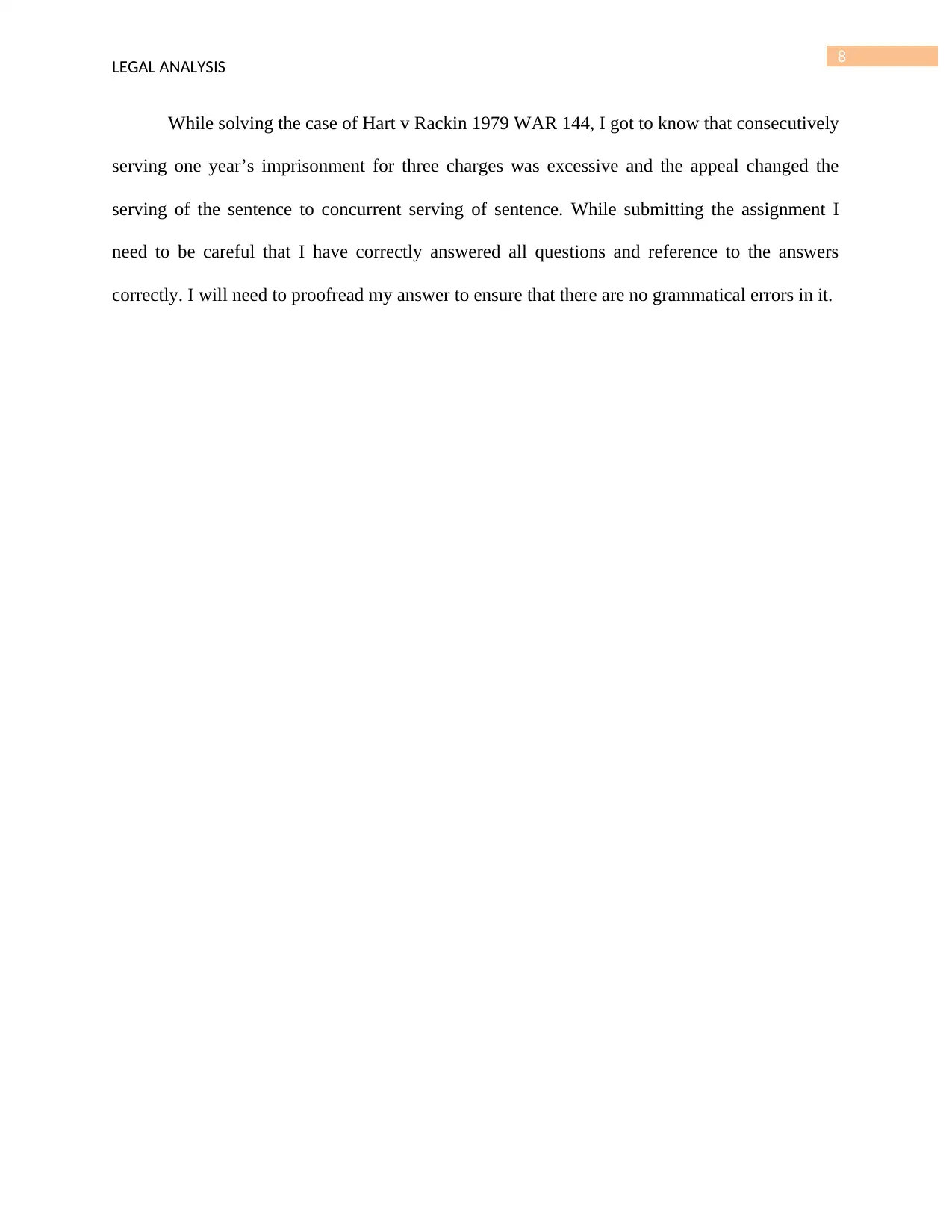
8
LEGAL ANALYSIS
While solving the case of Hart v Rackin 1979 WAR 144, I got to know that consecutively
serving one year’s imprisonment for three charges was excessive and the appeal changed the
serving of the sentence to concurrent serving of sentence. While submitting the assignment I
need to be careful that I have correctly answered all questions and reference to the answers
correctly. I will need to proofread my answer to ensure that there are no grammatical errors in it.
LEGAL ANALYSIS
While solving the case of Hart v Rackin 1979 WAR 144, I got to know that consecutively
serving one year’s imprisonment for three charges was excessive and the appeal changed the
serving of the sentence to concurrent serving of sentence. While submitting the assignment I
need to be careful that I have correctly answered all questions and reference to the answers
correctly. I will need to proofread my answer to ensure that there are no grammatical errors in it.
⊘ This is a preview!⊘
Do you want full access?
Subscribe today to unlock all pages.

Trusted by 1+ million students worldwide
1 out of 9
Related Documents
Your All-in-One AI-Powered Toolkit for Academic Success.
+13062052269
info@desklib.com
Available 24*7 on WhatsApp / Email
![[object Object]](/_next/static/media/star-bottom.7253800d.svg)
Unlock your academic potential
Copyright © 2020–2025 A2Z Services. All Rights Reserved. Developed and managed by ZUCOL.




![R v HEVKO [2018] SASCFC 22: Analyzing Home Detention Bail Order](/_next/image/?url=https%3A%2F%2Fdesklib.com%2Fmedia%2Fr-v-hevko-case-study_page_2.jpg&w=256&q=75)
![University Law Case Study: R vs. Smith [2003] QCA 76](/_next/image/?url=https%3A%2F%2Fdesklib.com%2Fmedia%2Fimages%2Fci%2F394dee3982ef454f9e4a28ed0b06d045.jpg&w=256&q=75)